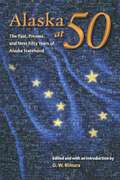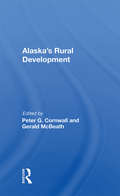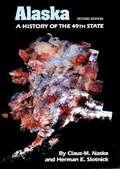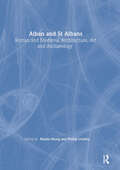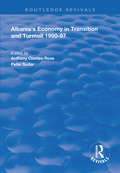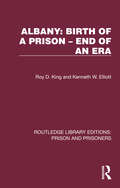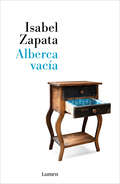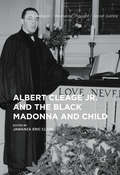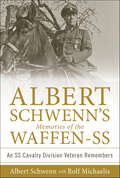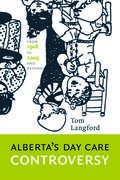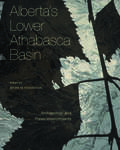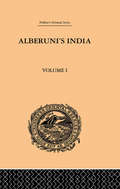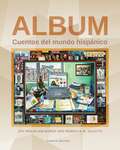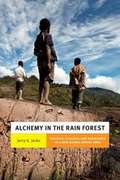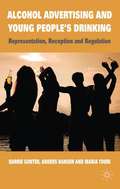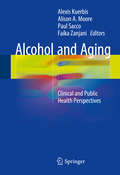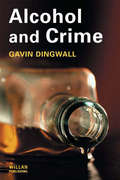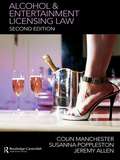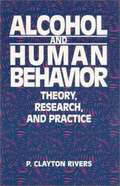- Table View
- List View
Alaska Native Tribes,ANCSA Corporations, and Other Organizations: Origins, Purposes, and Relationships
by Lydia HaysLearn about Alaska's unique indigenous people who have lived thousands of years in a subsistence economy and unconquered. See how today's Alaska Native people exhibit remarkable resilience and adaptability despite the arrival of foreigners to Alaska in the mid-1700s, who sought natural resources and brought death and disease that claimed many indigenous lives. Clear descriptions, facts, charts, lists, and maps tell about the 230 Alaska Native tribes and more than 350 Alaska Native-owned for profit and nonprofit organizations that have emerged over the past 65 years. A stunning 25,000 year timeline depicts archeological sites which helped provide the basis for aboriginal land rights in the historic Alaska Native Land Claims Settlement in 1971. Today, Alaska Native people comprise about 20 percent of Alaska's population and their institutions are a major player in Alaska's diverse economy. Easy to read, you will gain an essential understanding about these modern institutions that have been successfully integrated with traditional subsistence values and are improving the lives of Alaska Native people and all of Alaska.
Alaska at 50: The Past, Present, and Future of Alaska Statehood
by Gregory W. KimuraIn 2009 Alaska celebrates its fiftieth anniversary of U.S. statehood. To commemorate that milestone, Alaska at 50 brings together some of today’s most noteworthy and recognizable writers and researchers to address the past, present, and future of Alaska. Divided into three overarching sections—art, culture, and humanities; law, economy, and politics; and environment, people, and place—Alaska at 50 is written in highly accessible prose. Illustrations and photographs of significant artefacts of Alaska history enliven the text. Each contributor brings a strong voice and prescription for the next fifty years, and the resulting work presents Alaskans and the nation with an overview of Alaska statehood and ideas for future development.
Alaska's Rural Development
by Peter G. Cornwall Gerald McBeathThis book examines the social, economic, political, and cultural concerns surrounding the development of rural Alaska. The authors explore the controversy over rural development from a variety of perspectives-some supporting economic development and its implications for rural communities, others arguing for alternative approaches. They raise the issues of external control over local development and the effects of the boom-and-bust cycle often associated with rural change. Part 1 surveys the economic development of Alaska's resources, providing an historical overview of its fur, timber, and fishing industries and examining the current importance of oil, gas, minerals, and agricultural products. The section concludes with a discussion of the unique patterns of trade between Alaska and Asia. The second part turns to the organizations that have been, and are presently, the major vehicles for development-the village and regional corporations that grew out of the Alaska Native Claims Settlement Act of 1971 and the non-profit organizations responsible for social services and education. The authors also discuss the increasingly important role of governmental institutions. The final section considers the conflict between the goal of economic development and traditional Native values of subsistence and cultural preservation. The authors ask whether the development of Alaska's rural regions must take place at the expense of the traditional lifestyle and cultural distinctiveness of Native society.
Alaska: A History of the 49th State (Second Edition)
by Claus-M. Naske Herman E. SlotnickThe largest by far of the fifty states, Alaska is also the one of greatest mystery and diversity. Geological forces have made its more than half-million square miles a region of breathtaking beauty and awesome contrasts. And, as Claus-M. Naska and Herman E. Slotnick show in this revised and updated edition of their book, the history and development of Alaska’s peoples has matched the diversity of its landscapes and seascapes.
Alaska: A Man from Kanatak (The Story of Paul Boskoffsky)
by Lloyd Mattson Paul BoskoffskyALASKA: A Man from Kanatak first appeared in 2002. The warm reception accorded the book in Alaska and beyond led us to this revision book. The first edition told of the grave illness of Paul and Nattie's lovely daughter, Jewell. This revision tells of her sad home going in May, 2004 and includes some of her writings.
Alban and St Albans: Roman and Medieval Architecture, Art and Archaeology (The British Archaeological Association Conference Transactions)
by Philip Lindley Martin HeingThis is a collection of eighteen papers presented at a conference that was held at the Hatfield Campus of the University of Hertfordshire with 122 members and guests from the United Kingdom, the United States of America, Germany and Norway were present. The papers are on the research on various aspects of the art and architecture of the abbey, at St Albans and provides an ideal forum for bringing together many aspects of the abbey’s history.
Albania's Economy in Transition and Turmoil 1990-97 (Routledge Revivals)
by Petar Sudar Anthony Clunies-RossFirst published in 1998, the contents of this book is the result of a series of studies by several Albanian scholars, in cooperation with contributors of differing nationalities, on various aspects of the Albanian economy during its ‘transition to market’. This study’s multiple aim is to provide an accessible body of information for outsiders interested in Albania ; to provide locally based teaching material for Albanian economics students; and to also clarify policy issues.
Albany: Birth of a Prison – End of an Era (Routledge Library Editions: Prison and Prisoners)
by Roy D. King Kenneth W. ElliottOriginally published in 1977, Albany: Birth of a Prison - End of an Era attempts to document and analyse some of the changes which happened in the first five and a half years of the prison’s opening and as far as possible account for them. Albany was planned and built as a medium-security establishment but the growth in the prison population meant it ended up, in part, as a maximum-security unit. At the time the prison was notorious, after a stormy series of incidents culminated in an alleged mass escape attempt and a riot, it had become known as the ‘jail of fear’ in which ‘mafia groups’ were said to ‘terrorize’ staff and prisoners alike. Despite the account inevitably being incomplete, it was hoped that lessons could be drawn, both for social research and social policy in regard to prisons.
Alberca vacía
by Isabel ZapataEn Alberca vacía, Isabel Zapata nos recuerda que la vida se descubre y se significa en la danza de lo inmediato, en cada gesto, en cada duelo, en cada plato de lentejas. -Prólogo de Alejandro Zambra- No son cartas febriles, aunque en todas late una intensidad dulce y melancólica. Juntas componen una cartografía diversa: van de la traducción a la maternidad y la pandemia, de los subrayados como formas de ternura al germen de futuro que se incuba en toda alberca vacía. Encontramos también una historia de las virtudes perrunas, un pequeño tratado sobre la libertad y el decoro a propósito de los bufets, y una lección, a vuelo de pájaro, sobre las posibilidades de migrar dentro de nuestra propia casa. «Estos ensayos nos interpelan, a veces de forma directa, otras veces velada, como con una amabilidad tácita.» -Alejandro Zambra
Albert Cleage Jr. and the Black Madonna and Child (Black Religion/Womanist Thought/Social Justice)
by Jawanza Eric ClarkIn this collection, black religious scholars and pastors whose expertise range from theology, ethics, and the psychology of religion, to preaching, religious aesthetics, and religious education, discuss the legacy of Albert B. Cleage Jr. and the idea of the Black Madonna and child. Easter Sunday, 2017 will mark the fifty year anniversary of Albert B. Cleage Jr. 's unveiling of a mural of the Black Madonna and child in his church in Detroit, Michigan. This unveiling symbolized a radical theological departure and disruption. The mural helped symbolically launch Black Christian Nationalism and influenced the Black Power movement in the United States. But fifty years later, what has been the lasting impact of this act of theological innovation? What is the legacy of Cleage's emphasis on the literal blackness of Jesus? How has the idea of a Black Madonna and child informed notions of black womanhood, motherhood? LGBTQ communities? How has Cleage's theology influenced Christian education, Africana pastoral theology, and the Black Arts Movement? The contributors to this work discuss answers to these and many more questions.
Albert Meets America: How Journalists Treated Genius during Einstein's 1921 Travels
by József IllyThis volume of news articles from Einstein’s first trip to America explores his rise a public figure and the creation of his celebrity persona.When a British expedition confirmed Albert Einstein’s general theory of relativity in 1919, the news catapulted the German physicist to global fame. Two years later, he joined a fund-raising tour through the United States—a country he’d never seen before—gathering support for the Hebrew University of Jerusalem. His lectures in New York, Princeton, and Chicago, and comments on the Jewish presence in Palestine, made Einstein one of the first media stars. In Albert Meets America, József Illy presents a fascinating compilation of media stories written during Einstein’s trip that cover his science, his Zionism, and the anti-Semitism he encountered. Traveling with Einstein from headline to headline, readers experience his emotional connection with American Jews and his frustration at becoming world famous even though his theories were not truly understood.This collection gives readers an intimate glimpse into the life of one of the world’s first modern celebrities and a unique understanding of the media’s power over both its subject and its audience.
Albert Schwenn's Memories of the Waffen-SS: An SS Cavalry Division Veteran Remembers
by Rolf Michaelis Albert SchwennA firsthand account from a member of the SS Cavalry Division, and SS Cavalry Training and Replacement Battalion
Alberta's Day Care Controversy: From 1908 to 2009 and Beyond
by Tom LangfordDay care in Alberta has had a remarkably durable history as a controversial issue. Since the late 1950s, disputes over day care programs, policies, and funding have been a recurring feature of political life in the province. Alberta’s Day Care Controversy traces the development of day care policies and programs in Alberta, with particular emphasis on policy decisions and program initiatives that have provoked considerable debate and struggle among citizens. For most of Alberta’s first fifty years as a province, day care was treated as a private rather than a public issue. Beginning in the late 1950s, however, debates about day care began to appear regularly on the public record. Dr. Tom Langford brings to light the public controversies that occurred during the last four decades of the twentieth century and the first decade of the new millennium, placing contemporary issues in historical context and anticipating the elements of future policy struggles.
Alberta's Lower Athabasca Basin: Archaeology and Palaeoenvironments
by John W. Ives Alwynne B. Beaudoin Angela M. Younie Brian M. Ronaghan Brian O. Reeves Duane G. Froese Elizabeth C. Robertson Eugene M. Gryba Gloria J. Fedirchuk Grant M. Clarke James A. Burns Janet Blakey Jennifer C. Tischer Laura Roskowski Luc Bouchet Murray Lobb Nancy Saxberg Raymond J. Le Blanc Robert R. Young Robin J. Woywitka Stephen A. Wolfe Thomas V. Lowell Timothy G. FisherOver the past two decades, the oil sands region of northeastern Alberta has been the site of unprecedented levels of development. Alberta's Lower Athabasca Basin tells a fascinating story of how a catastrophic ice age flood left behind a unique landscape in the Lower Athabasca Basin, one that made deposits of bitumen available for surface mining. Less well known is the discovery that this flood also produced an environment that supported perhaps the most intensive use of boreal forest resources by prehistoric Native people yet recognized in Canada. Studies undertaken to meet the conservation requirements of the Alberta Historical Resources Act have yielded a rich and varied record of prehistoric habitation and activity in the oil sands area. Evidence from between 9,500 and 5,000 years ago—the result of several major excavations—has confirmed extensive human use of the region’s resources, while important contextual information provided by key geological and palaeoenvironmental studies has deepened our understanding of how the region’s early inhabitants interacted with the landscape. Touching on various elements of this rich environmental and archaeological record, the contributors to this volume use the evidence gained through research and compliance studies to offer new insights into human and natural history. They also examine the challenges of managing this irreplaceable heritage resource in the face of ongoing development. Contributors: Alwynne Beaudoin, Angela Younie, Brian O.K. Reeves, Duane Froese, Elizabeth Roberston, Eugene Gryba, Gloria Fedirchuk, Grant Clarke, John W. Ives, Janet Blakey, Jennifer Tischer, Jim Burns, Laura Roskowski, Luc Bouchet, Murray Lobb, Nancy Saxberg, Raymond LeBlanc, Robert R. Young, Robin Woywitka, Thomas V. Lowell, and Timothy Fisher
Alberuni's India: An Account of the Religion, Philosophy, Literature, Geography, Chronology, Astronomy, Customs, Laws and Astrology of India: Volume I
by Edward C. SachauThis is Volume IX of eleven in a collection of India: History, Economy and Society. Originally published in 1910, this is the first part of an account of the religion, philosophy, literature, geography, chronology, astronomy, customs, laws and astrology of Alberuni's India about A.D. 1030.
Alberuni's India: An Account of the Religion, Philosophy, Literature, Geography, Chronology, Astronomy, Customs, Laws and Astrology of India: Volume II
by Edward C. SachauThis is Volume X of eleven in a collection of India: History, Economy and Society. Originally published in 1910, this is the second part of an account of the religion, philosophy, literature, geography, chronology, astronomy, customs, laws and astrology of Alberuni's India about A.D. 1030.
Alchemy in the Rain Forest: Politics, Ecology, and Resilience in a New Guinea Mining Area
by Jerry K. JackaIn Alchemy in the Rain Forest Jerry K. Jacka explores how the indigenous population of Papua New Guinea's highlands struggle to create meaningful lives in the midst of extreme social conflict and environmental degradation. Drawing on theories of political ecology, place, and ontology and using ethnographic, environmental, and historical data, Jacka presents a multilayered examination of the impacts large-scale commercial gold mining in the region has had on ecology and social relations. Despite the deadly interclan violence and widespread pollution brought on by mining, the uneven distribution of its financial benefits has led many Porgerans to call for further development. This desire for increased mining, Jacka points out, counters popular portrayals of indigenous people as innate conservationists who defend the environment from international neoliberal development. Jacka's examination of the ways Porgerans search for common ground between capitalist and indigenous ways of knowing and being points to the complexity and interconnectedness of land, indigenous knowledge, and the global economy in Porgera and beyond.
Alcohol Advertising and Young People’s Drinking
by Barrie Gunter Anders Hansen Maria TouriThere is widespread and growing concern about the use of alcohol in society, especially by young people. Although overall volumes of alcohol consumption may be levelling off, the occurrences of excessive or 'binge' drinking, especially among teenagers and young adults, are increasingly commonplace. Tackling irresponsible drinking, which is linked to other antisocial behaviour and health problems, has focused attention on the promotion of alcohol by its producers as an important causal factor. This has led to calls for tougher regulation of alcohol marketing, including restrictions on where it can occur and the form it is allowed to take. Empirical research evidence, often emanating from government funded enquiries and endorsed by health lobbies, has been cited in support of an allegedly primary role played by advertising in triggering interest in and the onset of alcohol consumption among young people and in encouraging regular and heavy drinking. Close examination of this evidence, however, reveals that the research is not always as cut and dried as it may first appear. Methodological weaknesses abound in studies of the purported effects of alcohol advertising and other forms of marketing and the significance specifically of advertising as an agent that shapes young people's alcohol consumption could be weaker than often thought. This book sets out a review and critique of the evidence on alcohol advertising and marketing effects on young people and considers this evidence in relation to codes of advertising and marketing practice.
Alcohol Problems in the Community
by Larry HarrisonCommunity surveys reveal that about 6% of the adult male and 1% of the adult female population in England and Wales are drinking at high risk levels. Alcohol Problems in the Community examines the implications of recent community care legislation for government policy on alcohol. The first part of the book begins with a report on recent US research on the role of alcohol in the perpetration of child abuse and recent research on young people's drinking problems. This is followed by a study on the prevalence of drinking problems amongst older people which has been underestimated. In the second half of the book empirical evidence is presented on the particular difficulties faced by ethnic, migrant and homeless groups and this emphasis on the centrality of social disadvantage leads on to a consideration of a specific social work role in the assessment and management of alcohol-related problems. Alcohol Problems in the Community is aimed at social work practitioners and students on prequalifying, qualifying and postqualifying social work courses, and it addresses key social work issues in relation to poverty, homelessness, discrimination and drinking problems.
Alcohol Use/Abuse Among Latinos: Issues and Examples of Culturally Competent Services
by Melvin DelgadoIn Alcohol Use/Abuse Among Latinos: Issues and Examples of Culturally Competent Services, you will learn how to design and improve services for Latinos with substance abuse problems by understanding that the cultures and personal backgrounds of your clients are crucial to the counseling process. This text will also show you how these service skills apply to the individual, family, or an entire community. Studies show that, according to patients, culturally sensitive and responsive practitioners are generally more credible, trusted, and effective. Alcohol Use/Abuse Among Latinos takes into account several different aspects that will help you develop these traits and provide successful services for Latinos dealing with alcohol or other drug problems. You&’ll gain valuable insight into:the five elements that are vital to a successful ATOD (Alcohol, tobacco and Other Drug) service--multiculturism, resilience/strengths, competence, community capacity development, and community participation--plus a detailed explanation of why they are needed step-by-step instructions for using three methods, supervision, inservice training, and consultation, as means of providing ongoing learning of cross-cultural competencies to practitioners why key factors such as economic background, gender, and sexual orientation need to be taken into consideration for ATOD services to be effective demographic patterns and case studies of Latino users and abusers of alcohol and other drugs that illustrate the growing number of Latinos in need of ATOD services why the practitioner needs to be aware of how family importance, values attached to cooperation versus competition, sociability, respect, and action-oriented problem-solving play a role in effective services for Latinos the need for practitioners to understand how ethnic identity, biculturality, Spanish language fluency, gender-specific role expectations, skin color, and overall sense of self can affect the success of services for Latino teenagers how excessive marketing of alcohol to Latino communities, lack of representation, and a lack of community involvement are key barriers to successful ATOD services for LatinosAlcohol Use/Abuse Among Latinos also discusses Latino mens’and womens’individual needs concerning substance abuse. One of the topics addressed, the loss of self-esteem, has been found to be a contributing factor to alcohol use and abuse for Latinas. It offers ways you can promote self-esteem in your Latina clients by focusing on their cultural heritage and pride. In addition, this text takes a unique look Latina lesbians and how training through educational and agency internship programs can promote awareness to your clients&’ special needs concerning substance abuse. Alcohol Use/Abuse Among Latinos will help you provide all of your Latino clients with efficient and culture-friendly services for resisting or overcoming the abuse of alcohol, tobacco, or other drugs.
Alcohol and Aging: Clinical and Public Health Perspectives
by Alexis Kuerbis Alison. A. Moore Paul Sacco Faika ZanjaniThis book provides a current perspective on alcohol and aging to better understand the trends, costs, benefits, and clinical and community evidenced-based strategies. This book embraces not only the physical, cognitive, psychological, and social health benefits of moderate drinking in the elderly, it also delves into the risks of excessive drinking, including physical and psychiatric morbidity, neurodegeneration, medication complications, and accidents and injuries, and loss of independence. Written by experts in the field, this book is the only current text that includes the most current scientific, research, empirical, and practice information alongside a comprehensive review of the status of the field that will help guide alcohol use management and stimulate future research. Alcohol and Aging is the ultimate resource for all researchers, educators, clinicians, and professionals working with older adults who drink.
Alcohol and Crime
by Gavin DingwallAlcohol is massively associated with crime. Evidence from the British Medical Association found that alcohol use is associated with 60-70 per cent of murders, 70 per cent of stabbings, 50 per cent of fights or assaults in the home. For non-violent offences the association is very strong as well: 88 per cent of those arrested for criminal damage, 83 per cent for breach of the peace, 41 per cent for theft and 26 per cent for burglary, had drunk in the four hours prior to their arrest. At the same time there has been intense concern about public drunkenness in town and city centres, especially on the part of young people, and the cost and damage this causes. This book seeks to understand the nature of the connection between alcohol and crime, and the way the criminal justice system responds to the problem, providing a clear and accessible account and analysis of the subject. It draws upon a wide range of sources and research findings, and also sets the subject within a broader comparative context. It takes an interdisciplinary approach, and includes a sociological account of the role of alcohol in British society, a criminological analysis of the link between alcohol and crime and a philosophical consideration of individual responsibility for harm caused whilst intoxicated, and a legal analysis of different approaches that can be adopted as a response to alcohol-related offending.
Alcohol and Entertainment Licensing Law
by Colin Manchester Susanna Poppleston Jeremy AllenThis comprehensive and authoritative guide to licensing law is co-authored by the UK’s only professor of licensing law and two eminent licensing practitioners. It provides a detailed exposition and contextual analysis of the legal provisions governing the licensing of alcohol and entertainment under the Licensing Act 2003, encompassing both the legislative and decision-making framework of the Act as well as its implications for human rights. Fully updated and revised, it covers the various forms of authorization for licensable activities and licence and certificate conditions that might be attached as well as the enforcement and appeal provisions of the Act. This new edition, building on the highly acclaimed original work published in 2005, includes subsequent legislative changes and case law decisions. New additions to this edition include: expanded coverage of enforcement provisions and police powers a revised and extended chapter on appeals, in light of the practical and procedural developments that have evolved in the appeal process amendments to existing regulations and the revised Statutory Guidance issued in 2007. This book is essential reading for all local authorities, legal advisers, licensing policy advisors, operators and the police as well as those applying for licences.
Alcohol and Human Behavior: Theory, Research, and Practice
by P. Clayton RiversSurveys the critical issues discussed in the field, pointing out how each issue has been approached from several theoretical perspectives.

